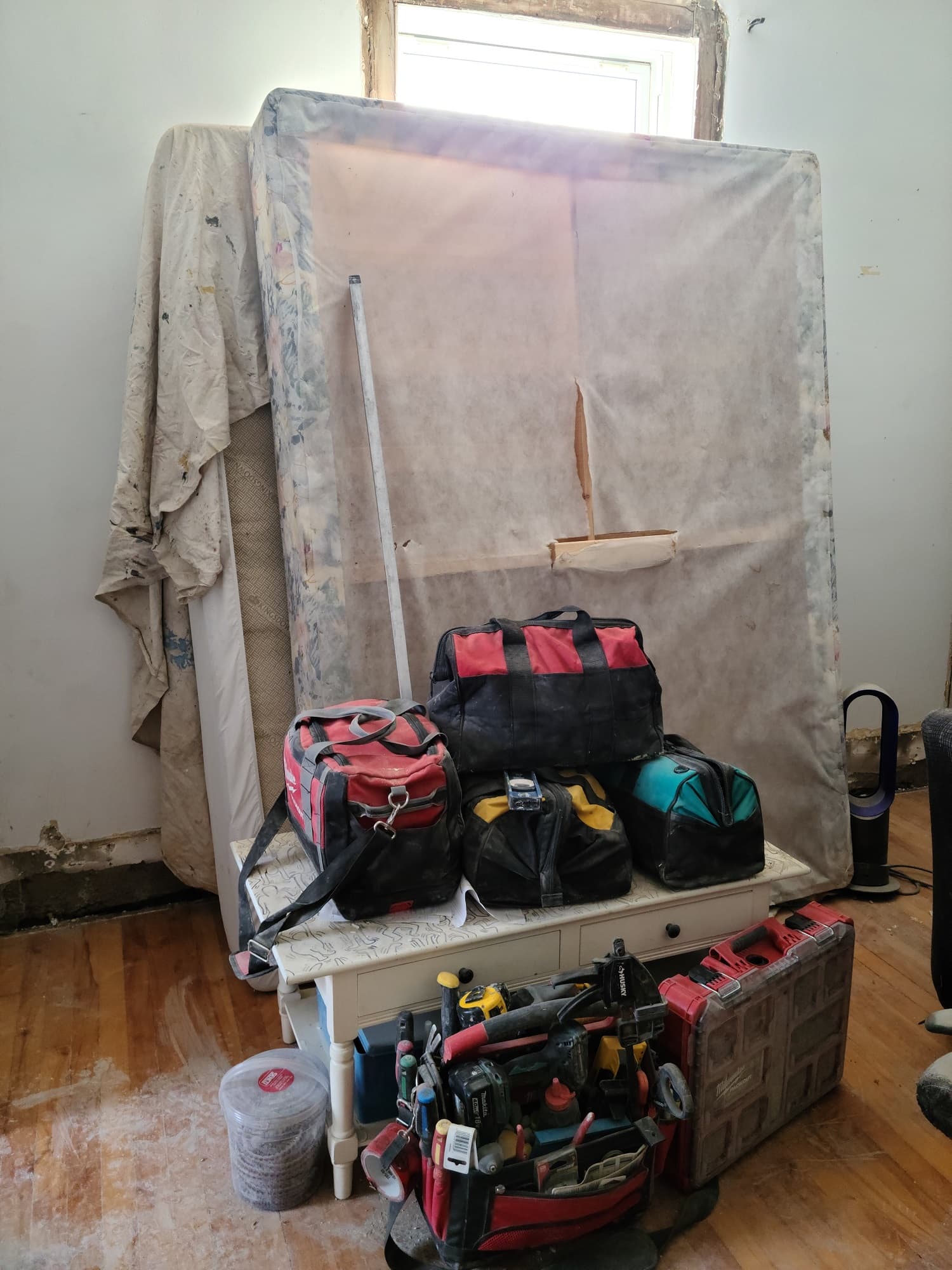
Caulking guns are the must-have tool to make quality caulk joints. Depending on the surface you intend on caulking, investing in a battery-powered gun can turn out to be quite a worthwhile solution.
Learn how to use one, what accessories to purchase, as well as a few simple tips and tricks for professional-looking caulk joints.
What Is the Best Way to Use a Caulk Gun?
To use a caulk gun under the best possible conditions, not only do you need to familiarize yourself with the steps detailed below, but you should also have the right accessories on hand.
Must-Have Accessories for an Effective Caulk Joint

Nozzle Tips
One nozzle tip is good, but two are better. Why, you ask? Because you might—especially so if you’re a novice—cut the nozzle tip too short. As a result, the nozzle will be too wide, dispensing too much sealant for the joint size.
Instead of going through the trouble of caulking with the wrong tip size, switch out the tip, cutting it down to the right size. Nozzle tips retail for less than $4.
Wipe-Down Blade
Wide-down knives are fitted with a carbon steel blade and are multi-purpose, allowing for the following:
Drive-in drywall nails
Install joint tape
Scrape and smooth
Repair drywall
Evenly spread sealants
For less than $20, you can get yourself a 4-inch taping knife.
Cleaning Tools
If you plan on caulking around your house, you're likely replacing deteriorating joints. As such, remember to remove the old sealant prior to applying a new caulk joint. You’ll also need the right tools to clean the intended surfaces:
Long nose pliers for rubber joints
Heat gun for acrylic joints
Electric knife for polyurethane and silicone joints
Once you’re stripped off all joints, use a solvent on all intended surfaces to ensure they’re properly prepped for the new joints. If you’re in a hurry, use a heat gun to dry the surface faster.
Caulking Gun: User Guidelines

Preparation
Start by using a clean caulking device, meaning that the gun should be cleaned after every use to prevent:
the device from malfunctioning;
a build-up of caulk; and
wasting time.
Once your caulk gun is back to its former glory, choose the right caulking tube, ensuring it fits without having to force it in place. Otherwise, you risk breaking the caulking device.
Note: The steps to properly clean a caulking gun are detailed at the end of the article.
Cut the Nozzle Tip
There are two ways to go about it:
You can use the blade fitted inside the caulk gun’s handle.
You can snip off the tip using a utility knife or scissors.
First off, check the caulk gun’s handle because it most likely has a hole for that very purpose. If so, use it to snip off the tip. Simply stick the tip in the hole at a 45° angle, and pull the trigger to cut it off.
Next, most caulk guns are equipped with a thin and pointy barrel holder. The latter can be used to punch a hole in the bottom of the tube, puncturing the inside seal. If your gun doesn’t have one, then move on with either the utility knife or scissor route.
A utility knife or a pair of scissors can come in handy to cut the tip of the caulking tube. The only thing you should focus your attention on is the angle of the cut. When caulking corners, cut the tip at a 90° angle, otherwise, stick to a 45- to 60-degree angle. Make sure the nozzle is slightly smaller than the space itself.
If you don’t have a steel rod to cut the inside seal, use a nail that’s long enough to punch a hole.
Caulking Process
For a professional-looking caulk joint, the tip of the nozzle should form a 45° angle with the surface on which the sealant is applied. Most importantly, be light on the trigger. Proceed carefully and slowly, spreading the caulk over the surfaces evenly.
However, should you proceed too slowly, the caulk joint won’t properly adhere to the surface. Therefore, you have to find the right amount of pressure to apply and do so evenly throughout.
On the other hand, the speed at which you proceed isn’t the sole determining factor that will ensure the caulk joint adheres to the intended surface. The surface’s cleanliness also matters. Cleaning the surface with a solvent to remove all traces of grease, oil, or other type of residue is paramount.
Smooth Out the Caulk Joint
First, knowing what makes the perfect caulk joint is helpful:
½ inch (12 mm) thick bead
45° angle
You can either use a putty knife meant for smoothing out joints or a popsicle stick coated in a non-stick substance to smooth the bead to create the perfect, even seal.
The purpose of smoothing out the bead of caulk is to remove all imperfections found on the joint, such as bubbles. If you’ve used silicone- or water-based caulk, yet using a popsicle stick or putty knife is out of the question, you can resort to dipping your fingertip in soapy water and running it along the bead.
Tips and Tricks for Professional-Looking Caulk Joints

Smoothing and Shaping Technique
No matter the tool used, meaning a putty knife or your fingertip, using the right technique to smooth a caulk joint is crucial. Proceed in one continuous motion.
Note that you risk damaging the bead of caulk by repeatedly smoothing it.
Steady Pressure
This is the hardest part of the job as it can’t really be put into words or depicted. Only experience allows you to apply the right amount of pressure to achieve a seamless caulk joint.
A lack of pressure will prevent the bead from adhering to the substrate properly, just like too much pressure can dispense too much caulk at once, resulting in the bead oozing out of the joint.
As such, if you’ve never caulked a joint, make a few practice beads on a specially prepared medium.
Smudge Prevention
When applying sealant with a caulk gun, you may notice sealant trickling out of the tip even when you've released the trigger. This is a result of the pressure contained within the tube.
To avoid that, and smudging your work, simply poke two small holes in the bottom of the tube with a knife prior to securing it in the holder. The holes alleviate pressure, preventing the caulk from oozing.
Caulking Quick Fixes: Solutions to Common Problems
Problems likely to occur while carrying out caulking work all stem from one issue: the nozzle’s tip.
A perfectly cut caulk tube nozzle means the tip will glide over the surface seamlessly, achieving the perfect seal. Note that if you stick to the guidelines detailed below, you can achieve high-quality results the first time around:
Cut the tip at a 45° angle
Scuff the tip at an angle using sandpaper
Mark the tip with a Sharpie to ensure it’s always facing the right way up
Applying these guidelines will make the job at hand much easier and more efficient.
Manual and Powered Caulking Guns

Battery-Powered Caulk Guns
Battery-operated caulk guns are professional tools. Not only do these allow for 500 pounds of pressure, but they also feature the previously mentioned blade to snip the tip of the tube and a non-drip unit.
Simply put, with this tool, there’s no need to punch a couple of holes in the bottom of the tube to prevent run-on. As soon as you release the trigger, the plunger reverts and releases the pressure on the tube.
Better still, once you’ve set the device to the right pressure, it’ll never change.
Its price tag is its only drawback: it retails for over $100.
18V Cordless Power Caulk Gun
An 18V caulk gun can generate more than 750 pounds of pressure. In other words, this tool can be used to apply all types of sealants, no matter the product’s viscosity.
With a capacity of 4.0 Ah, 18V batteries can typically power through at least 200 caulk tubes before needing a recharge.
Cordless Caulk Gun
Cordless caulk guns can either be manual or battery-powered. In either case, it’s cordless, but the prices vary considerably.
As mentioned, battery-operated caulk guns cost between $100 and $600, while manual devices aren’t more than $80. Low-end models (ratchet rod caulk gun) cost less than $20.
So, opt for a manual caulk gun if you’re not a professional and don’t intend to use such a tool very often, and solely looking to caulk around your bathroom. If you plan on caulking all around the house, a battery-powered caulk gun may be the best option.
Two Well-Known Brands of Caulk Guns
DEWALT Caulk Gun
DEWALT caulk guns are professional-grade tools that suit homeowners and industry professionals alike, performing on-site jobs.
This battery-operated gun also features the following:
Variable speed trigger
Variable speed dial
Anti-drip feature
Inter-changeable canister trays
With this type of gun, you’ll look for joints to seal.
BOSCH Caulk Gun
Bosch is one of the top tool industry leaders. To keep up with the competition from the likes of DEWALT, the company is developing caulk guns with up to 790 pounds of thrust and a full range of options:
Non-drip
Rotatable gun
Lightweight
9-speed settings
Fits an array of tube sizes
Hook for hanging
However, this brand features among the most expensive with guns costing more than $300 apiece.
Caulk Gun Maintenance and Care

Maintenance
The degree of difficulty when it comes to cleaning entirely depends on the type of caulk you use:
Latex
Silicone
For latex, clean the gun with hot water and soap, wiping the device dry with a damp cloth. However, when it comes to silicone, removing this sort of sealant is a tad harder, especially when it has dried atop the tool.
Use the same method as mentioned above: hot water and soap. But, wipe it dry with a dry cloth.
If you’ve waited until the sealant dried to clean your tool, remove the bulk of it using a two-inch putty knife.
Lubricate
The same thing applies if you don’t lubricate the gun’s moving parts. A bit of lubricant can work wonders when applying caulk. Indeed, it ensures a:
Smoother plunger
Better application
Simpler cleaning process
Proper Storage
Where you choose to store your caulk gun will determine its service life. To ensure its durability, store it somewhere that’s:
Out of children’s reach
In a dry and cool area
That way, not only will it not rust, but it won’t turn into a toy should your kids get their hands it on.
Caulk Gun: The Go-To Tool for a Meticulous Finish
Caulking guns are the perfect tool for any job involving impeccable sealing and finishing. Its ease of use, application precision, and versatility make it an essential tool for renovation and construction projects. Whether for sealing joints, repairing cracks, or applying sealants, this tool delivers ease of use and professional results. The key is choosing a quality gun that's tailored to your needs.
Get 3 quotes for your weatherization project
RenoQuotes.com can help you get quotes from a general contractor. By submitting your project, we’ll put you in contact with top-rated contractors. Fill in the form on the homepage (it only takes a few minutes) and get estimates from trusted professionals.
Dial 1-844 828-1588 to speak with one of our customer service representatives.
Looking for something else?
Related articles
The latest industry news, interviews, technologies, and resources.

Editorial Team
•06 Aug 2024
The digital realm has evolved exponentially over the years, and home automation systems are following suit. A home automation system allows you to remotely control a myriad of devices and equipment in your home thanks to technology such as the Internet of Things (IoT) and artificial intelligence (AI). However, while these systems offer unprecedented connectivity, they also present some downsides.

Editorial Team
•17 Dec 2024
As metropolitan areas are seeing a surge in population, more than ever, people are seeking smaller living spaces, and are keen on making the latter as cozy and versatile as possible, for the long haul. This phenomenon, combined with an increasingly competitive housing market, is not all that surprising that upon finding the perfect apartment, people prefer staying put rather than considering another move.

Amanda Harvey
•07 Nov 2023
Is your home ready for a much-needed renovation? Do you feel like you're prepared to take on the job? Many homeowners feel as though everything has already been considered and arranged, but there are often aspects of home renovations that are overlooked and can lead to serious problems down the line.

Amanda Harvey
•07 Nov 2023
Welcome back for the second installment of our monthly round-up! If you've found yourself about to dive into this article, we imagine that you’re a fellow home design, decor and renovation enthusiast. We too share this passion and thought it’d be fun to create a series that looks at the most interesting articles we've found on the internet that covers these subjects.

Christine Simard
•07 Nov 2023
With fall at our doors, the feeling of wanting to cuddle up in a cozy blanket with a hot beverage is being felt by many. While in relaxation mode, your bedroom's ambiance will play an important role on your mood. This is why the colour of your walls should be chosen according to what you want to reflect.